
Formerly a French colony, Chad is one of the most sparsely populated countries in the world, as most of it lies either within the Sahara Desert or the semi-arid belt of the Sahel. Serving as a cultural bridge between North and Sub-Saharan Africa, Chad is a mosaic of hundreds of ethnic groups, split culturally and religiously between the lush savannahs in the south and the barren desert in the north. While a trip to Chad is definitely not for the fainted hearted and requires weeks of pre-planning, the country has a lot of awe-inspiring places to offer for any intrepid traveler who opt to come.
By far the most populous city in the country, Chad’s capital, N’Djamena is light years apart from being a typical modern metropolis as one might expect. Excluding very few places such as five stars hotels, expat facilities and the airport, the city has an exceedingly chaotic and rowdy nature. Pothole ridden dirt roads, a traditional dress code of pastel-colored boubous, hectic traffic and widespread informal commerce make N’Djamena one of Africa’s most interesting, yet challenging capitals to visit.
Ravaged by a series of recent uprisings, revolts and military conflicts, it should come as no surprise that the city is home to very few places that can be deemed as tourist attractions. Place de La Nation, the city’s main square, known for its monumental arch and numerous sculptures, together with the presidential palace, the Grande Mosquée, the cathedral and the central market are probably the only sites that genuinely can be considered as somewhat touristy.
However, despite its lack of eye-catching landmarks, any akin adventurist would find N’Djamena as a fascinating city to explore. Mud houses alongside dilapidated colonial buildings serve as a backdrop for ultra-authentic scenery, where flocks of roaming camels share the roadside with street hawkers who sell practically anything.
Flowing along the city’s southwestern parts, the Chari River is not only an indispensable water source for N’Djamena’s residents but also the international border between Chad and Cameroon. If you wish for a brief respite from the extreme hustle and bustle of the Chadian capital, you’ll be glad to learn that the Chari riverfront has incredibly spectacular sunsets that offset any kind exhaustion after an intense urban experience.

Place de La Nation with its monumental arch and the national flag
photography by: Superyouss
It’s difficult to overstate the sheer importance of Lake Chad not only to the country with which it shares the name, but also to Nigeria, Niger and Cameroon, all of which encompass together one of Africa’s greatest lakes. Due to the rapid population growth, inefficient irrigation methods and climate change, the lake has shrunk significantly since the 1960’s. In fact, in just 60 years this ancient body of water lost 95% of its original size, amounting to a meager 1,540 km2 as of 2020.
While the ecological crisis prompted many challenges, including armed conflicts between the different ethnic groups along its coastline, the lake is still largely an oasis in an otherwise arid region. If you bother to check the travel advisories of different countries, you’ll notice that Lake Chad is defined as an unsafe region to visit. Nevertheless, if you hire a local guide, you’ll most likely be out of harm’s way, as the risky places are confined to specific areas.
Home to dozens of migratory birds and wild African mammals, Lake Chad alternates between a shallow water lake and wetlands, the latter of which even awarded it as a Ramsar site. If you manage to overcome the many logistic challenges of visiting the area, you should definitely take a boat ride with local fishermen through the lake’s reed labyrinth. It’s not only an exceptional experience but also an insightful journey into why this lake is so crucial for the survival of millions of people in this unforgiving corner of the world.
Aside from its relatively lush southern tip, Chad is vastly dominated by the world’s largest desert, the Sahara. Unlike one would assume, this arid landscape is dotted with tens of deep-desert springs, two most famous of which are Guelta d’Archei and Guelta de Bachikele. The Arabic word of “Guelta” is directly translated as Oasis, reflecting the essence of those two remote hideaways.
Tucked away in the far reaches of Chad’s Ennedi Plateau, Guelta d’Archei has served for centuries as a resting spot for caravans and local tribes who crossed the vast expanses of the Sahara. Flanked by breathtaking 120-meter-tall vertical cliffs, this secluded oasis is frequented all year round by groups of nomadic people, accompanied by their flocks of dromedaries.
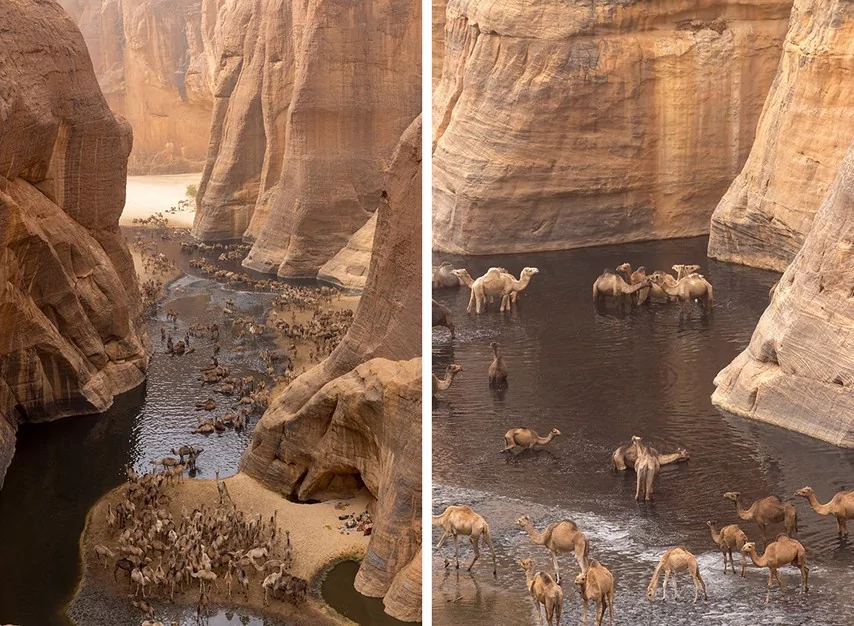
Groups of camels slake their thirst in the waters of Guelta d'Archei
photography by: Valerian Guillot
Interestingly, the spring’s water is noticeably murky, the result of camels constantly dropping their dungs into the water. This smelly phenomenon might make the water unswimmable and undrinkable for humans, yet it generates a unique eco-system where a poop-eating algae feeds scores of fish, that in turn become the main source of food for the rare desert crocodiles that inhabit the Guelta.
Lying 75 kilometers away, in first glance Guelta de Bachikele might be far less impressive than its mentioned above peer. However, with cleaner water that are safe for both drinking and bathing as well as a local colony of baboons to socialize with, this awe-inspiring place provides an authentic desert experience, perfectly suited for thrill seekers.
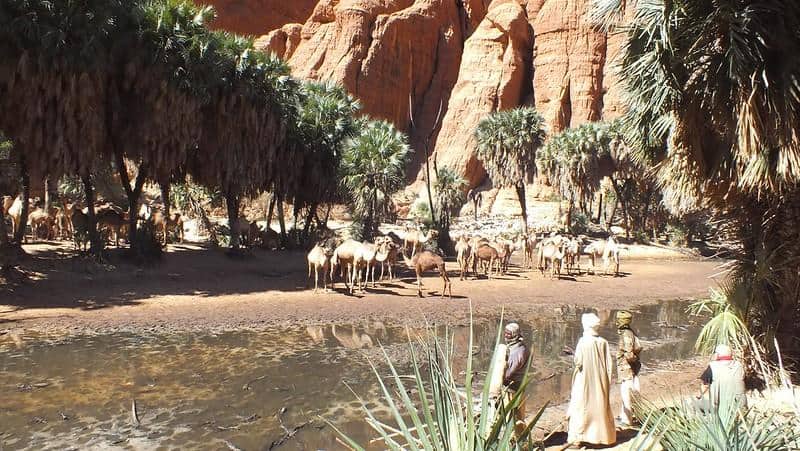
Tribesmen and their camels in Guelta de Bachikele
photography by: Emilien Lebourgeois
At the northern tip of Chad lies a string of volcanoes known as Tibesti Massif. comparable in size to South Korea, this mountain range is one of Africa’s most isolated regions, littered with numerous geological oddities that virtually make the area looks like as if it’s from another planet.
Soaring to a whopping 3,415 meters, Emi Koussi is not only the tallest volcano among the Tibesti Mountains, but also the highest point in the entire Sahara Desert. Its 19-kilometer-diameter crater has three calderas, one of which is covered by a thick white layer of snow-like natron salt, a relic of its distant past, when a salty lake encompassed the whole caldera.
The last time this gargantuan 70-kilometer-wide volcano erupted was approximately 2 million years ago. However, the mountain still has some thermal activity, including a couple of literally breathtaking fumaroles that emit volcanic steam and gases, and due to Emi Koussi’s remote location, were discovered only recently after a group of scientists analyzed a series of satellite photos. There are also several hot springs across the base of the volcano that worth a visit.
While visiting this sparsely populated mountain ridge is an unforgettable lifetime experience, it entails many logistic challenges to overcome. Two N’Djamena-based travel agencies infrequently organize expeditions to the Tibesti massif, involving a 5-day-long journey northward followed by intense ascent. Climbing your way to one of the summits is almost always accompanied by camel caravan and guided by a local Toubou tribesman.
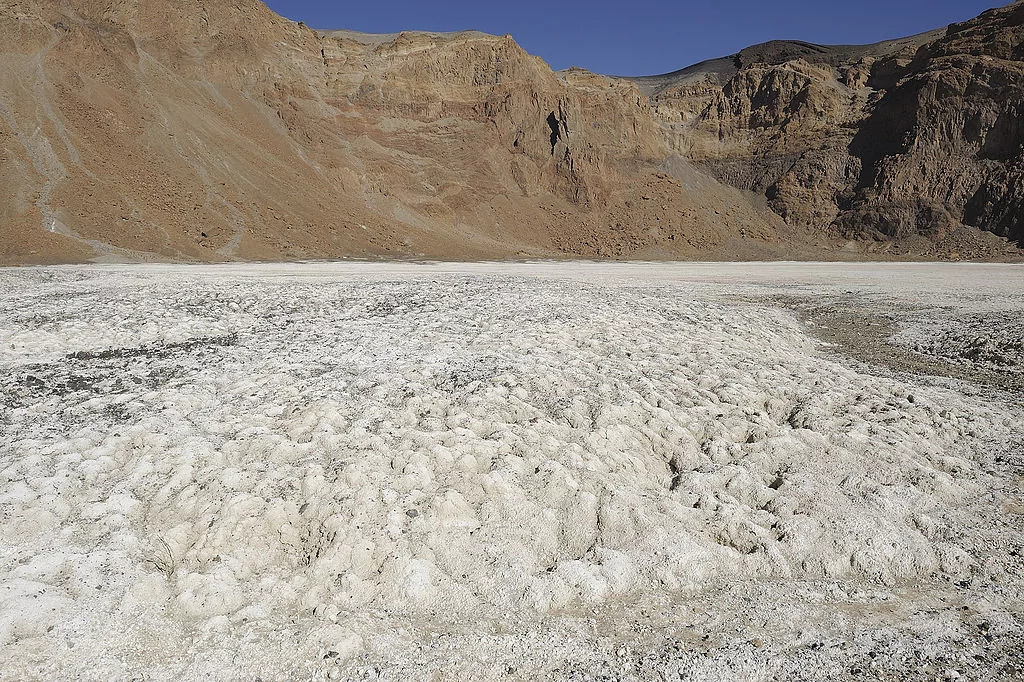
The snow-like carpet of salt in Emi Koussi's crater
photography by: Stefan Thüngen
Nestled in the southern fertile part of the country, Zakouma is Chad’s oldest national park and a sheer contrast from the desert terrain that dominates much of the Chadian countryside. Since its establishment in 1963, the park underwent an incessant struggle to keep its wildlife safe from ongoing human encroachment.
The high levels of extreme poverty in Chad coupled with the region’s political instability put a strain on the park as some people see poaching as a legitimate way to escape economic hardships. This trend ultimately culminated in the notoriously brutal carnage of the park’s elephants by the Sudanese Janjaweed gangs between 2002 to 2010, dwindling their numbers from several thousands to a meager 450.
Fortunately, in 2010, an NGO named “African Parks” was commissioned by the Chadian government to restore Zakouma National Park’s once ample wildlife. Following a decade of intense law-enforcement and educational efforts among local communities, elephants and other animals seen their numbers dramatically recover.
Visiting the park is far beyond simply enjoying its immense bio-diversity, as the tourism sector provides a viable income source, and thus an alternative to poaching. Several tour operators in N’Djamena offer safari excursions to Zakouma, often including also a fascinating trip to Guera’s iconic granite monadnocks.
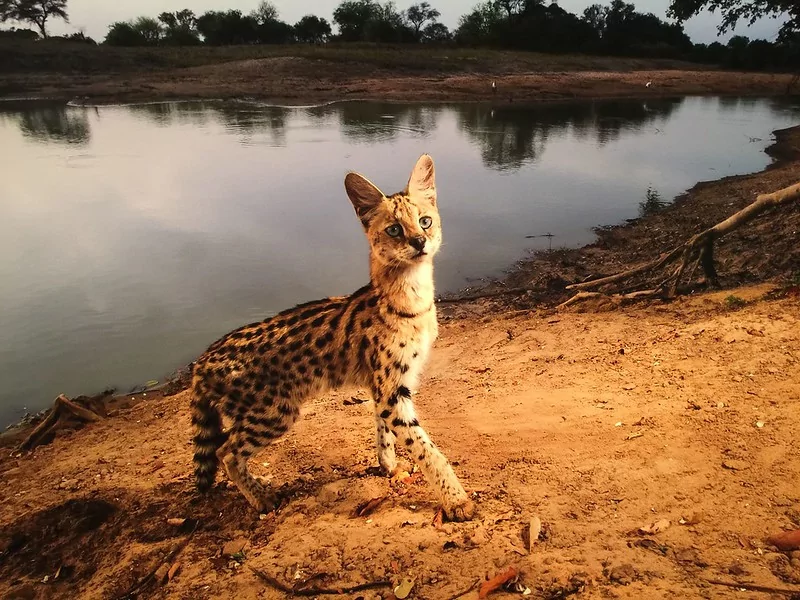
An adorable serval cat in Zakouma National Park
photography by: Laura Blanchard
Hidden in the faraway region of Ennedi Plateau, Aloba Arch is one of Africa’s best kept secrets. Natural arches are a geological rarity that barely exists outside of southwestern China and the Colorado Plateau in Utah, therefore Aloba Arch is deemed incredibly unique by global standards. Whereas its span of 77 meters is relatively modest, the arch towers to a staggering 120 meters, making it one of the tallest in the world.
Its formidable and exceptional appearance on the backdrop of the mystic desert landscape that is dotted with acacia trees and surrounded by a rocky massif is a mesmerizing sight to behold, and even more so after sunset, when the arch is accompanied by a night sky full of stars.
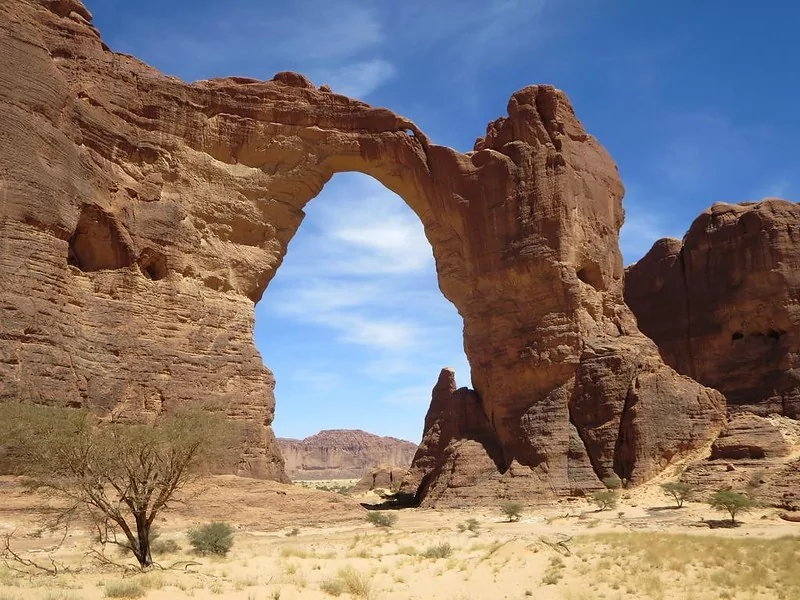
Aloba Arch at its fullest glory
photography by: David Stanley
Despite its remarkable features, the arch is rarely visited by foreign tourists due to its sheer inaccessibility, as well as the general challenges of traveling through Chad.
While it’s widely agreed that arch was formed as a result of erosion by wind and rainfalls, not much else is known about this natural wonder as it was never thoroughly studied by scientists.
Roughly 16 kilometers southwest of Aloba Arch, facing the west side of Mt. Anoko, lies yet another breathtaking geological formation. The Five Arch Rock, as it’s unofficially called, is a giant monolith with 5 arch-like openings, the largest of which is 19 meter wide and 22 meter tall. Punctured by those giant voids, the rock is probably the perfect place for a lunchtime break, taking refuge from the scorching Chadian sun.
Nestled within the vast expanses of the Ennedi Region in northern Chad, the lakes of Ounianga provide one of the most surreal sights in all of Africa, so much so, that in 2012, this oasis was recognized as a UNESCO world heritage site. This group of 18 deep-desert lakes vary in size, salinity, color and fauna. The lakes are divided into two sub-clusters that are 60 kilometers apart, each of which with a village along its banks, Ounianga Kebir (the large Ounianga) and Ounianga Serir (the small Ounianga).
Interestingly, the Ounianga lakes are a vestige of distant era, when the Sahara Desert was a lush area brimming with life. Back then, the lakes were part of a much larger body of water, which ultimately shrunk to its current size following a gradual climate change that resulted in the region’s desertification about 11,000 years ago.
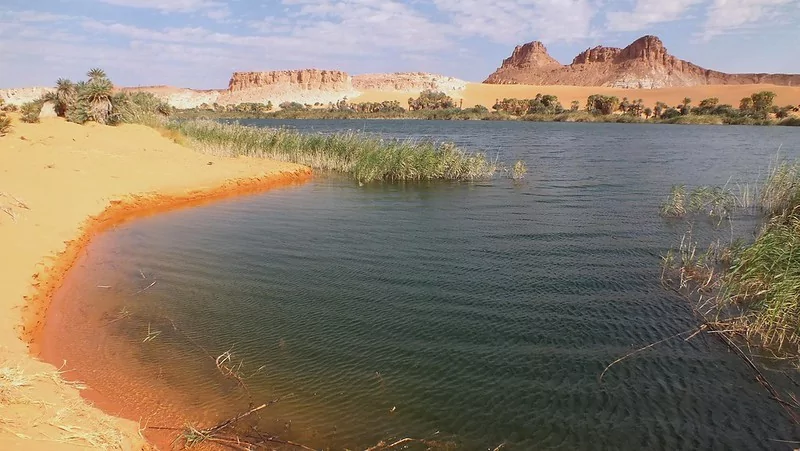
Elimé Lake near Ounianga Sérir
photography by: Emilien Lebourgeois
Despite the miniscule average rainfall of 2mm a year and large evaporation rate, the lakes have managed to survive thanks to a unique phenomenon, where they get constantly replenished by groundwater.
Among all of Ounianga lakes, the largest and most famous one is undeniably Lake Yoa, measuring 4 km2 with a maximum depth of 26 meters, known for the breathtaking contrast between its deep blue waters and the surrounding golden dunes. Tens of kilometers away, near the village of Ounianga Serir, are a series of lakes, including freshwater lakes that are partly covered by reeds and remarkably, support a sizeable population of endemic fish.
All of the lakes are separated by slender strips of drifted sand that accumulated over time. Amazingly, in one case a narrow sandy barrier separates between a reddish and turquoise lakes, a jaw dropping sight to awe at, merely one of many reasons why the week-long treacherous journey northwards is worth the hassle.
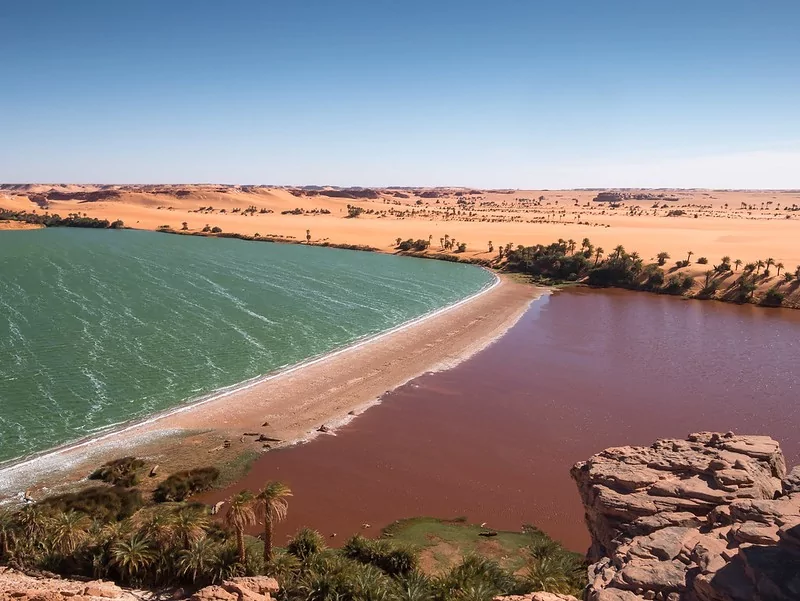
The small strip of sand separating between the two colorfully parts of Lake Katam
photography by: anmede
Approximately 80 kilometers from N’Djamena, the charming village of Douguia is considerably more accessible than most of the mentioned-above places. Sitting along the Chari River, this traditional fishing village became somewhat of a hotspot in recent years, attracting akin adventurists who are looking for a unique experience without the trouble of venturing out to the country’s faraway northern regions.
Dotted with beige mud houses that form narrow alleys, Douguia offers an authentic glimpse to the daily lives of Chadian villagers, yet with a greater extent of comfort and modern amenities. Any visit to this riverside village always culminates in a boat trip with a wooden pirogue across the Chari River, spotting flocks of waterfowls and hippos.
Any organized trip from N’Djamena to Douguia will most likely include the nearby (35 kilometers from Douguia) awe-inspiring Elephant Rock, known locally as Hadjer Lamis. Millenia of steady erosion sculptured this granite inselberg into an elephant shaped crag, which still enjoys a relative anonymity, after all, it’s located in one of the least visited countries in Africa.